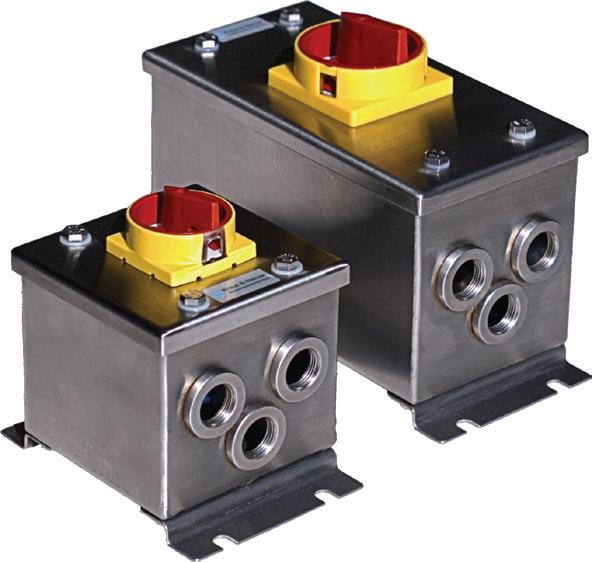
15 minute read
Developing active packaging to preserve food and reduce waste
Image credit: Ryan Young/Cornell University In the lab, biologically derived polymer is grafted onto a plastic disc to demonstrate how it may be used in food packaging.

Developing
active packaging to preserve food and reduce waste
Cornell University scientists are finding ways to make active packaging materials that can address both the consumer demand for fewer preservatives and the environmental need for less plastic in packaged food. The latest research, which was published in June in the journal Food Packaging and Shelf Life, uses biologically derived polymer that helps salad dressings, marinades and beverages last longer in the fridge.
“Active packaging gives us a new way to prolong shelf life despite consumer demands for cleaner labels,” said Ian Kay, a doctoral student in food science. “But it’s tricky. Foods and beverages have varying and complex composition, so we need to know a lot about the chemistry of the food and the active packaging to figure out which system works for which foods.”
Joshua Herskovitz, who studied in the laboratory of Julie Goddard, professor of food science in the College of Agriculture and Life Sciences, grafted the corn-derived polylactic acid polymer with the antioxidant nitrilotriacetic acid to use it in food packaging. Kay, following up on Herskovitz’s work, figured out the material’s ‘interfacial pKa’, which tells you at which pH the foods in this packaging might work to keep from spoiling.
As the antioxidant is bound to the polylactic acid, the preservative can interact with the food but not migrate into it.
“In other words, you get the shelf-life benefit of the preservative without consuming it,” Goddard said. “This allows for cleaner label foods, which consumers are really looking for these days.”
“As a food scientist, I’m excited about new ways to reduce food and packaging waste,” Goddard said. “I’m not antipreservatives as a whole, we need to remember things we use in the kitchen like heat, salt and lemon juice are important ingredients in food preservation.
“So if we take preservative out of our food, at the same time, we need to think about the environmental impact if food spoils faster,” Goddard said. “Using a greener active packaging technique, we can extend shelf life while moving closer to a circular plastic economy.”

The use of Radial Flow Column (RFC) for large-scale chromatography processes

Michael Feische, Head of R&D, Albert Handtmann Armaturenfabrik GmbH & Co. KG
Huge market growth
Lactoferrin (LF) is found in the milk of all mammalians, also in milk and whey derived from cow milk. It is an 80 kDa iron-binding protein and represents about 0.3% of the total protein content of milk, which equals 60–200 mg/L. The thermal stability is 55°C.
Lactoferrin is a very powerful protein: it has antibacterial, antiviral, antifungal, anti-tumor, anti-inflammatory and anti-allergic effects. Isolated from cow’s milk, it is therefore a soughtafter additive for foods such as functional food or sports nutrition. The use of lactoferrin has exploded in recent years, particularly as a supplement for baby nutrition. Column chromatography

In chemistry, chromatography refers to all those physico-chemical separation processes in which the separation process is based on the distribution of a substance between a mobile and a stationary phase. Different substances of a sample are retained to different degrees by the stationary phase, while the mobile phase takes over the transport. Chromatographic analysis methods can include the following: classical column chromatography, highperformance liquid chromatography (HPLC) or ion exchange chromatography (IEX) as a special form of HPLC.
Fast protein liquid chromatography (FPLC) is a form of high-performance liquid chromatography that is often used for the analysis or purification of protein mixtures. In FPLC, the mobile phase is an aqueous solution or ‘buffer’. The buffer flow rate is controlled by a positive displacement pump and maintained at a constant flow rate. For equilibration and elution, substance-specific buffers are required. To adapt the elution to the substance to be separated, the buffer composition can be varied by dosing the individual components from external containers. The stationary phase is usually a spherical resin, which for example consists of cross-linked agarose or polymethacrylates, packed in a cylindrical stainless steel column. FPLC resins are available in a wide range of particle sizes and surface modifications, depending on the application.
In ion exchange chromatography, substances can be separated according to their charge. It is based on the formation of heteropolar bonds between the matrix and the mobile phase, whereby the desired charged protein binds. The elution can be done by means of gradients. As soon as the charge binding between eluent and protein is higher than between matrix and protein, the protein migrates into the solution. By detecting the flow at 280 nm, any passing protein can be detected as a peak. In lactoferrin recovery, LF is obtained by ion exchange chromatography.
RFC columns for lactoferrin extraction
What is radial flow?

The radial flow stands for a continuous flow and high flow rate through the entire adsorber (24/7), a low differential pressure at a high flow rate, the processing of large feed volumes and a good scalability by increasing the separation distance of the corresponding radial flow column.
More advantages of RFC are the following: • Bidirectional flow • Ability to sterilise and autoclave the column • Availability of different screen sizes • Small footprint • Low dead space volume • Minimum P • Robust design • Specific packing station for easy packing and unpacking, together with minimizing chromatographic resin losses
The standard column volume (CV) is 240 and 260 litres respectively at a separation distance of 13.5 cm. In principle, up to 2000 litres of resin volume per column are possible. For beer applications, this will allow processing flow rate of ~ 22,000 litres per hour, for milk applications ~15,000 litres per hour.

Axial vs. radial flow column
While an axial flow column design offers the advantage of a higher flexibility in the separation distance, the radial flow column has much more to offer. Below are the specifications for a radial flow column, which make a radial flow column superior to an axial flow column: • Reduced pressure drop of 20–50 % • Improved loading efficacy • Reduced feed handling complexity • High binding kinetics (dynamic binding capacity) • High process robustness (larger process tolerance window) • Higher throughput • Higher efficiency • Higher purity
Is it possible to convert existing processes from axial to radial flow columns?
A conversion from an axial to a radial flow column is possible as long as the required separation distance for the efficient separation is max. 13.5 cm, which is in most of the ionexchange based chromatography processes the case. The change from axial to radial can be justified as described above: radial flow columns have significantly lower pressures than axial columns. This means that the column can be operated at a higher flow rate, resulting in a higher throughput and, in relation to time, a higher turnover. Albert Handtmann Armaturenfabrik GmbH & Co. KG www.handtmann.de
For more details, contact Handtmann Group’s Australian agent, Sandy Ross at Rossbrew on sandy@rossbrew.com.au.
Radial throughflow
Example for axial and radial flow chromatography flow patterns
How to extract lactoferrin from milk
For the industrial extraction of the protein lactoferrin from milk and whey, radial flow columns are used. The whole milk is collected at dairy farms and stored in refrigerated conditions until quality test passed and transported to a dairy processing facility. Once the milk arrives at the dairy facility, it undergoes cream separation to remove fat and collect skim milk. Then the skim milk goes through a pasteurizer to kill pathogenic bacteria before any further process. For bovine lactoferrin (bLF) extraction, the ideal option is to extract the lactoferrin before the pasteurizer process step. In such cases, skim milk is pumped through a chromatography column packed with a suitable resin (strong ion exchanger) until the maximum binding capacity of the resin has been reached. The column is then washed with water and low salt buffers, before the bovine lactoferrin is eluted by applying a buffer with high salt solution. Afterwards the resin in the column is regenerated for next purification cycle by a CIP procedure using sodium hydroxid (NaOH). The purified lactoferrin-/salt solution is further processed to remove the salt and concentrate the solution by diafiltration (DF) and ultrafiltration (UF). LF is further concentrated using a second UF process step and then dried using freezedrying or spray drying technologies. The powder is formulated and packed to a desired pack size. Process flow of lactoferrin extraction
Applications of column chromatography
In addition to lactoferrin extraction, the radial flow column is also used in the food industry and in large-scale chromatography processes. Here are just a few areas of application: • Bitter substances from citrus juices • Polyphenol reduction in beer • Taurine extraction • Extraction of potato protein • Taste and smell removal from collagen • Removal of riboflavin from whey • Milk and whey protein purification

Round bar material for food sector
Treotham has expanded its range of igus iglidur round bars with four materials; among them two for the food sector: the heat-resistant material iglidur AC500 and the resilient material A250. The hard-wearing material iglidur H3 and the wearresistant endurance material iglidur E complete the product range. This makes it possible to mill and turn lubrication-free and maintenance-free prototypes and special components for a wide variety of applications.
For the production of special bushings, rollers and other sliding elements that come into contact with food, igus has developed iglidur AC500 — an FDA-compliant high-temperature material for the food industry that withstands extreme temperatures of up to 250°C. Thus, components made of AC500 are suitable, among other things, for sliding elements in baking lines. When a plain bearing made of AC500 rotates on a high-grade stainless-steel shaft, wear is only 0.16 micrometres per kilometre, as tests in the in-house test laboratory showed. In addition, the material has high chemical resistance, so that it withstands cleaning agents common to the food industry. Lubrication is not necessary in this case. A double advantage, as the risk of contamination and the maintenance effort are reduced.
The iglidur A250 round bars from Treotham are also predestined for the food and packaging industry. They are suitable, among other things, for the production of so-called knife edge rollers, which are used in the deflection of conveyor belts. In this function, the material reduces the drive power required and the energy consumption of the belts thanks to its lowfriction, lubrication-free dry operation. In addition, the material impresses with its high load-bearing capacity. iglidur A250 is designed in such a way that it can be used for high belt speeds in the food and packaging industry. And just like AC500, A250 also has the approval for direct contact with food. The material complies with the hygiene guidelines of the US Food and Drug Administration (FDA) and EU Regulation 10/2011. iglidur H3 was developed primarily for contact with aggressive media and the application in pumps, eg, in fuel pumps. The fourth material is iglidur E, which is used to manufacture plain bearings that dampen vibrations in combination with aluminium shafts.
Treotham Automation Pty Ltd
www.treotham.com.au


Stainless steel enclosures
The new Kraus & Naimer enclosures added to the 6S Series of stainless steel enclosures provide rigorous protection for vital switchgear but with the same footprint as the plastic versions, combined with bottom threaded entries and four screw cover fixings with removable mounting feet.
Suitable for dairy and food & beverage industries, the enclosures can also be used in sewerage treatment plants, mining and marine.
The enclosures are Australian manufactured, constructed from 1.6 mm 316 stainless steel and are rated to IP66.
Kraus & Naimer can also meet users’ unique application needs, such as EMC/RFI screened glands suitable for stainless steel, mild steel or plastic enclosures.
Kraus & Naimer Pty Ltd www.krausnaimer.com.au
Air compressor
The latest compressor from Kaishan, the PMV 250, uses permanent magnet motors and variable frequency drive technology. The combination of integrated systemic optimisation of the compressor unit with an advanced permanent magnet motor, SKY 2-stage airend and rapid response variable speed drive is said to result in a compressor that needs less energy input to drive an efficient compressor while generating greater output.
Rare earth technology gives the permanent magnet motor higher energy efficiency compared to conventional induction motors. PM synchronous torque motors provide faster acceleration and deceleration, a great advantage in compressor applications as they can rapidly vary output to match application demands.
With integral variable speed control, the compressor operates at the level of immediate demand, reducing both input energy needs, machine wear and tear and maintenance requirements. These air compressors are therefore designed to deliver high efficiency and performance in a heavy-duty machine that is also said to possess durability and reliability.
Kaishan offers the PMV compressors in power ranges from 15 to 250 kW to suit the needs of a wide range of industry applications.
Kaishan Australia Pty Ltd
www.kaishan.com.au










AVEVA Plant SCADA 2020 R2 taps into the full potential of the AVEVA Portfolio
As global industry accelerates plans for digital transformation and seeks reliable and flexible SCADA solutions, many companies are shifting to tightly integrated stacks of solutions to solve increasingly interconnected operational challenges.
As HMI/SCADA software continues to evolve, AVEVA™ Plant SCADA has grown as well. You’ll find it easier than ever to explore solutions that deliver collaboration, skills management, deep analytics, and artificial intelligence. Industrial operations must reimagine traditional HMI/SCADA to support the future potential of operations control.
AVEVA Plant SCADA began its development lifecycle as a part of Citect, and quickly gained dominance of the SCADA market in the Asia Pacific region. When Citect became part of Schneider Electric and then AVEVA, Citect SCADA was integrated with the AVEVA portfolio.
Now, the same team who brought you Citect SCADA brings you AVEVA Plant SCADA. They’ve kept the features customers have come to rely on like legacy image libraries and graphics editors, but they’ve infused Plant SCADA with common tools shared across AVEVA’s rich portfolio, like

AVEVA Plant SCADA unlocks the full potential of integrated operations control
AVEVA is already exploring ways to bring the familiarity of traditional HMI/ SCADA software to a more integrated style of operations, centered around common information platforms and unified operations. AVEVA Plant SCADA represents an example of the way legacy SCADA software can be updated to play a powerful role in unified operations while maintaining features that customers have come to rely on over decades.

industrial graphics and a powerful read/write web client based on HTML5.
Comprehensive operations with AVEVA
AVEVA hasn’t just made this trusted SCADA software better, it has made it a full part of AVEVA operations capabilities. Operations control is a framework of information and teams that allow organizations to break down operational silos and show one unified vision of operations that managers and operators can use to make better decisions and improve processes.
Plant SCADA serves an important role within operations control, and organizations using Plant SCADA can already take advantage of other powerful AVEVA solutions designed to unify systems and teams. For example, Plant SCADA supports industrial graphics, which allows users to import and export rich graphics libraries to other systems.
AVEVA Connect is another important piece of the AVEVA operations control portfolio. Within AVEVA connect, Plant SCADA users can centralize their data with AVEVA Data Hub or use AVEVA Insight to understand their asset health and performance.
AVEVA Plant SCADA is also a part of AVEVA Flex, a subscription credits system that allows customers to use the entire AVEVA operations portfolio with much lower upfront costs. Want to use FLEX to augment Plant SCADA with the edge management solutions of AVEVA Edge? Now you can! Want to bring Plant SCADA data directly into a Unified Operations Center? AVEVA Flex makes it possible and cost-effective to start experimenting with more complex system architectures and take advantage of powerful automation tools.

AVEVA Select Distributors offer a personal touch
As an AVEVA Select Distributor, Schneider Electric offers the full AVEVA portfolio. This allows them to provide a personal touchpoint for companies executing their digital transformation plans as they explore new ways to structure their teams and break down information silos for a more unified experience of operations.
Schneider Electric’s partnership with AVEVA provides a rich set of solutions that help organizations optimize operations and asset performance, and more easily adopt technologies like artificial intelligence, industrial IoT, big data, cloud, and hybridcloud capabilities.
Upgrading to AVEVA Plant SCADA
AVEVA and Schneider Electric always recommend that you use the most recent versions of software to mitigate security risks and implement the latest features and capabilities. If you’re currently using a legacy edition of Citect SCADA, updating to AVEVA Plant SCADA will bring you the future-ready technology you need to stay competitive.
Never used AVEVA Plant SCADA? Contact our team to request a demo so we can demonstrate how you can reduce your operating costs and improve productivity and product quality.
Schneider Electric se.com/au/getreadyformore










